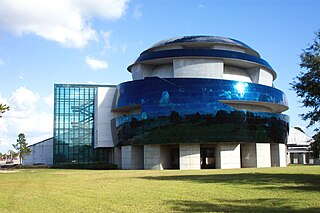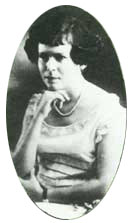Related Research Articles

The region known as Hispanic America and historically as Spanish America or Castilian America is all the Spanish-speaking countries of the American continent. In all of these countries, Spanish is the main language - sometimes sharing official status with one or more indigenous languages or English, and Latin Catholicism is the predominant religion.

The Museum of Science & Industry (MOSI) is a non-profit science museum located in Tampa, Florida.

Dr. Concha Meléndez was an educator, poet, and writer. She was the first woman to belong to the Puerto Rican Academy of Languages.
Luis Guinot Jr. was an American diplomat who was the U.S. Ambassador to Costa Rica from 1991 to 1993.
Hispanic and Latino Admirals in the United States Navy can trace their tradition of naval military service to the Latino sailors, who have served in the Navy in every war and conflict since the American Revolution. Prior to the Civil War, the highest rank reached by a Latino-American in the Navy was commodore. Such was the case of Commodore Uriah Phillips Levy (1792–1862), a Sephardic Jew of Latin American descent and great grandson of Dr. Samuel Nunez; Levy served in the War of 1812. During the American Civil War, the government of the United States recognized that the rapid expanding Navy was in need of admirals therefore, Congress proceeded to authorize the appointment of nine officers the rank of rear admiral. On July 16, 1862, Flag Officer David Glasgow Farragut became the first Hispanic-American to be appointed to the rank of rear admiral. Two years later (1864), Farragut became a vice admiral, and in 1866 the Navy's first full admiral. During World War I, Robert Lopez, the first Hispanic graduate of the United States Naval Academy, served with the rank of commodore in command of the Mare Island Naval Shipyard, and during World War II five Hispanics served with the ranks of rear admiral or above in either the European or Pacific Theaters of the war. As of April 2007, twenty-two Hispanic-Americans have reached the rank of admiral, and of this number thirteen were graduates of the USNA.
Hispanics in the United States Naval Academy account for the largest minority group in the institution. According to the academy, the Class of 2009 includes 271 (22.2%) minority midshipmen. Out of these 271 midshipmen, 115 are of Hispanic heritage. In 2004, of the total of 736 female midshipmen, 74 (10%) of them were of Hispanic descent.

Hispanic Americans, also referred to as Latinos, served in all elements of the American armed forces in the war. They fought in every major American battle in the war. Between 400,000 and 500,000 Hispanic Americans served in the U.S. Armed Forces during World War II, out of a total of 16,000,000, constituting 3.1% to 3.2% of the U.S. Armed Forces. The exact number is unknown as, at the time, Hispanics were not tabulated separately, but were included in the general white population census count. Separate statistics were kept for African Americans and Asian Americans.

Olga D. González-Sanabria is a Puerto Rican scientist and inventor. She is the highest-ranking Hispanic at NASA Glenn Research Center, and a member of the Ohio Women's Hall of Fame. González-Sanabria, Director of the Engineering and Technical Services, is responsible for planning and directing a full range of integrated services including engineering, fabrication, testing, facility management and aircraft services for the Glenn Research Center. She played an instrumental role in the development of the "Long Cycle-Life Nickel-Hydrogen Batteries" which helps enable the International Space Station power system.
Richard Velazquez is an American businessman. He was recognized in October 2000 as the 1st Puerto Rican automotive designer for Porsche in Germany.
The University High School, commonly referred to by its initials "UHS", in San Juan, Puerto Rico is a college preparatory laboratory high school operated by the Faculty of Education of the University of Puerto Rico. Located on the University of Puerto Rico, Río Piedras Campus, it provides education to approximately 514 students from 7th to 12th grade.

The recorded history of Puerto Rican women can trace its roots back to the era of the Taíno, the indigenous people of the Caribbean, who inhabited the island that they called Borinquen before the arrival of Spaniards. During the Spanish colonization the cultures and customs of the Taíno, Spanish, African and women from non-Hispanic European countries blended into what became the culture and customs of Puerto Rico.

Carmen Delgado Votaw was a civil rights pioneer, a public servant, an author, and community leader. She earned an associate degree at the University of Puerto Rico and graduated from American University in Washington, D.C., with a bachelor of arts in international studies. She was subsequently awarded an honorary doctorate in humanities by Hood College in Frederick, Maryland.
Luz Martinez-Miranda is an American-Puerto Rican physicist. She is currently an associate professor in the College of Materials Science and Engineering at the University of Maryland. Martinez-Miranda is an APS Fellow and was the first female president of the National Society of Hispanic Physicists.
References
- ↑ "Past Recipients". Archived from the original on 2013-09-27. Retrieved 2013-09-23.
- ↑ "About National Hispanic Scientist". Archived from the original on 2013-09-27. Retrieved 2013-09-23.
- ↑ "Hispanic Scientist of the Year". Archived from the original on 2013-09-27. Retrieved 2013-09-23.
- ↑ "MOSI hosts National Hispanic Scientist of the Year award recipient". Bay News 9 . Hillsborough County. 23 October 2016. Retrieved 13 July 2021.